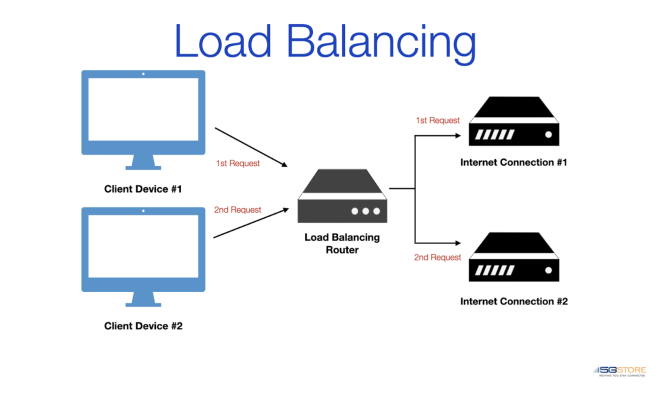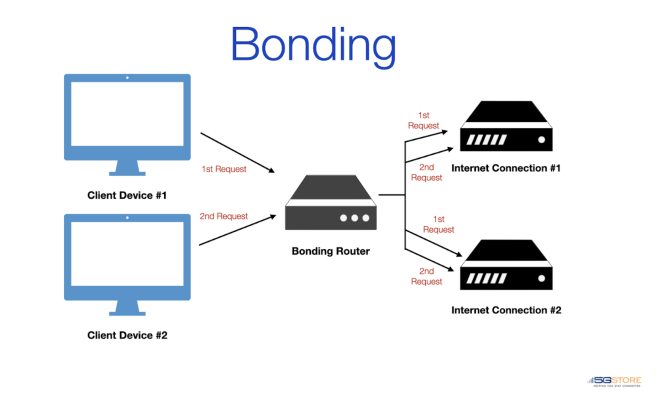
In today’s interconnected world, having a stable and fast internet connection is crucial for both individuals and businesses. These days, just about everything runs on the Internet. Things like our phones, TVs, credit card machines, thermostats, and security systems. When we rely on a single Internet connection we often encounter problems like choppy video chats, slow speeds, or even complete connection failures. Creating business continuity can easily be done by adding a secondary Internet connection. This can be used as a backup when your primary connection fails, which is why it’s normally referred to as “failover.” However, there’s another feature we want to explore with you that also utilizes multiple Internet connections, which is called bonding.
Failover with a Backup Internet Connection
Using a secondary connection from a different Internet service provider can sometimes be difficult. There may only be one reliable cable, DSL, or fiber Internet service provider available in your area. This results in many businesses choosing a wireless service provider instead. Providers like Verizon Wireless, AT&T, and T-Mobile have nationwide coverage available with easy to install hardware. You can normally have the connection up and running in under 15 minutes. When your primary connection fails, your computers and other devices disconnect temporarily, then reconnect to your secondary network to keep your business operating.
Due to this temporary loss in Internet, failover is most ideal for users and applications which do not require a 24/7 connection. In other words, those who can afford some downtime. The occasional home user, for example, may not mind having to wait a couple minutes before they can continue checking email or watching a video.
Load Balancing
With regards to routers, load balancing refers to the distribution of device traffic (i.e. browsing emails on your phone or playing videos on your computer) across multiple Internet connections. The purpose of load balancing is to optimize resource utilization, maximize speed, minimize response time, and avoid overloading any single Internet connection.
Load balancers act as intermediaries between client devices and the Internet connections they are accessing. They receive requests to access the Internet, distribute them among the available connections, and forward the responses back to the clients. This distribution can be based on various factors. That might be to evenly distribute device traffic across each Internet connection, or use the connection that has the fastest response time. Essentially, the router can intelligently select the best Internet connection to use, or it can split your devices evenly across the multiple Internet connections.
Still, failures can occur. Any devices connected to a failed connection will need to be rerouted back to an available Internet service, assuming there is one. This creates additional downtime for your devices since they will need to disconnect and reconnect to another service. So, load balancing is most useful for households or businesses that have several users or devices that need to connect to the Internet more frequently and reliably. For example, you would connect some of your devices over one Internet connection and other devices over a second Internet connection. This is mainly helpful with cellular networks that can slow down as more devices connect. Load balancing allows you to alleviate the load on an individual Internet service by splitting your device’s Internet traffic across multiple services simultaneously.

Poor Service vs No Service
On occasion, you may find your Internet connection to be slow or show intermittent issues like buffering video or choppy audio. Unfortunately, failover and load balancing routers do not have the ability to detect weak or spotty service. They only detect if the connection is available or not and sometimes how the connection performs. When you’re on a phone call, in a video meeting/ chat, or running a credit card, and your Internet connection fails, your call, meeting or transaction stops. You now have to re-establish your call, meeting or transaction over the secondary Internet service. No matter how this is done, it’s going to take time and effort on your part. Luckily, bonding can help you to avoid this disconnection.
Understanding Bonding
Bonding is the process of merging multiple internet connections to create a stronger and more efficient connection. Through specialized hardware or software, these connections are intelligently combined to form a single connection with improved capabilities. Instead of relying on just one connection, bonding distributes the load across multiple links, resulting in increased bandwidth speeds and a more reliable connection. This means instead of your phone call, video meeting, or credit card transaction dropping, bonding allows it to continue over your available Internet connection(s).
Bonding vs. Load Balancing
Bonding and load balancing are two different approaches to optimizing internet connectivity, though both work by using multiple Internet connections. Bonding involves combining multiple internet connections into a single virtual connection. In this case a network can merge the bandwidth of multiple weak or intermittent connections to create a single, more reliable high-speed connection. It works by combining the speeds of these connections and using a protocol to split network traffic across them.
Unlike bonding, load balancing doesn’t require specialized hardware or software. It distributes traffic across multiple connections based on predefined settings (called algorithms). When devices connect to the load balanced network they will only use one of the connections at a time. This is why when a connection fails, any device using that connection must stop its Internet activity and restart it using an established connection. Load balancing is beneficial for managing traffic efficiently and preventing bottlenecks in scenarios with multiple users or devices, but will not increase bandwidth speeds.
Bandwidth Speed
Bonding can be a lifeline for individuals in areas with only slow DSL services, for example, which limit internet speed and productivity. By combining multiple slow connections, bonding effectively increases the overall internet speed. It surpasses the limitations of individual links, providing a faster and more efficient online experience. This technology empowers individuals living in remote areas or regions with limited internet infrastructure to access the full potential of the digital world. It is also particularly advantageous for bandwidth-intensive applications like live video streaming or large file transfers.
Reliability and Redundancy
Bonding enhances reliability by providing seamless failover capabilities. If one connection fails, your Internet traffic keeps flowing over the remaining connections. This redundancy and resilience are crucial for critical applications requiring continuous and reliable internet access such as day trading or 24/7 surveillance.
Let’s say you have a VoIP (an Internet based phone) call established with an important client. If you’re using failover and your primary Internet connection fails during the call, the call is dropped. At that time, you have to connect your phone to your secondary Internet and start the call over. If you’re using load balancing, the call also drops, but the switch to another Internet connection is automatic rather than manual. Of course, failover can also be automatic if you’re using a router that supports this feature.
Bonding is the only feature that would allow your call to continue without any disruption. In fact, it should be unnoticeable. This is because unlike load balancing where device traffic is sent to individual Internet connections, bonding sends the traffic to ALL Internet connections at the same time. So, if one of those connections happens to fail, your device remains connected to the Internet as if the failure didn’t occur. Where failover creates some disruption in Internet service, bonding does not.

Enhancing Business Continuity
Businesses relying on internet connectivity for critical operations can greatly benefit from bonding. For example, Point of Sale (POS) systems, which require a stable internet connection for credit card transactions, can experience significant disruptions if the primary connection fails. By implementing bonding, a secondary connection is readily available to seamlessly take over, ensuring uninterrupted transactions. Bonding provides a failsafe mechanism to prevent potential losses and maintain customer satisfaction. Additionally, businesses utilizing internet-based phone services and video conferencing understand the importance of clear audio and video quality during calls. With bonding, multiple weak and/ or unreliable connections are combined into one robust link. This ensures uninterrupted and high-quality conversations, even if individual links fail.
Unleashing Connectivity on the Go
Frequent travelers or remote workers with limited internet access can benefit from bonding. By leveraging multiple cellular internet connections from different providers, bonding enables faster speeds and increased reliability. If one provider’s coverage is unavailable or weak, the other connections seamlessly take over, allowing users to stay connected without interruption. Whether you’re a digital nomad, a field professional, or an adventure seeker, bonding offers the flexibility and reliability needed to stay connected on the go.
The Solution is Bonding
Bonding is a revolutionary technology that significantly enhances internet connectivity in various scenarios. Whether you’re a business owner relying on seamless credit card transactions and phone services, a traveler in need of reliable connectivity, or an individual struggling with slow internet speeds, bonding offers a solution. By combining multiple connections into a single, more powerful link, bonding improves reliability, increases speed, and ensures uninterrupted connectivity. Embrace the power of bonding and unlock a world of enhanced internet experiences. Say goodbye to frustrating connection issues and welcome a seamless online journey.

